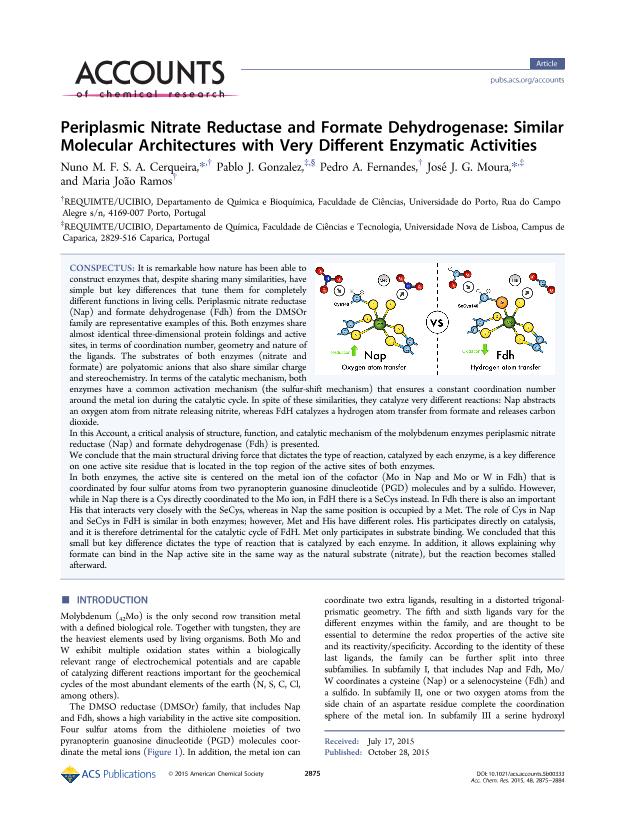Artículo
Periplasmic Nitrate Reductase and Formate Dehydrogenase: Similar Molecular Architectures with Very Different Enzymatic Activities
Cerqueira, Nuno M. F. S. A.; González, Pablo Javier ; Fernandes, Pedro A.; Moura, José J. G.; Ramos, Maria João
; Fernandes, Pedro A.; Moura, José J. G.; Ramos, Maria João
 ; Fernandes, Pedro A.; Moura, José J. G.; Ramos, Maria João
; Fernandes, Pedro A.; Moura, José J. G.; Ramos, Maria João
Fecha de publicación:
10/2015
Editorial:
American Chemical Society
Revista:
Accounts of Chemical Research
ISSN:
0001-4842
Idioma:
Inglés
Tipo de recurso:
Artículo publicado
Clasificación temática:
Resumen
It is remarkable how nature has been able to construct enzymes that, despite sharing many similarities, have simple but key differences that tune them for completely different functions in living cells. Periplasmic nitrate reductase (Nap) and formate dehydrogenase (Fdh) from the DMSOr family are representative examples of this. Both enzymes share almost identical three-dimensional protein foldings and active sites, in terms of coordination number, geometry and nature of the ligands. The substrates of both enzymes (nitrate and formate) are polyatomic anions that also share similar charge and stereochemistry. In terms of the catalytic mechanism, both enzymes have a common activation mechanism (the sulfur-shift mechanism) that ensures a constant coordination number around the metal ion during the catalytic cycle. In spite of these similarities, they catalyze very different reactions: Nap abstracts an oxygen atom from nitrate releasing nitrite, whereas FdH catalyzes a hydrogen atom transfer from formate and releases carbon dioxide. In this Account, a critical analysis of structure, function, and catalytic mechanism of the molybdenum enzymes periplasmic nitrate reductase (Nap) and formate dehydrogenase (Fdh) is presented. We conclude that the main structural driving force that dictates the type of reaction, catalyzed by each enzyme, is a key difference on one active site residue that is located in the top region of the active sites of both enzymes. In both enzymes, the active site is centered on the metal ion of the cofactor (Mo in Nap and Mo or W in Fdh) that is coordinated by four sulfur atoms from two pyranopterin guanosine dinucleotide (PGD) molecules and by a sulfido. However, while in Nap there is a Cys directly coordinated to the Mo ion, in FdH there is a SeCys instead. In Fdh there is also an important His that interacts very closely with the SeCys, whereas in Nap the same position is occupied by a Met. The role of Cys in Nap and SeCys in FdH is similar in both enzymes; however, Met and His have different roles. His participates directly on catalysis, and it is therefore detrimental for the catalytic cycle of FdH. Met only participates in substrate binding. We concluded that this small but key difference dictates the type of reaction that is catalyzed by each enzyme. In addition, it allows explaining why formate can bind in the Nap active site in the same way as the natural substrate (nitrate), but the reaction becomes stalled afterward.
Palabras clave:
Molibdeno
,
Nitrato Reductasa
,
Formato Deshidrogenasa
,
Dft
Archivos asociados
Licencia
Identificadores
Colecciones
Articulos(CCT - SANTA FE)
Articulos de CTRO.CIENTIFICO TECNOL.CONICET - SANTA FE
Articulos de CTRO.CIENTIFICO TECNOL.CONICET - SANTA FE
Citación
Cerqueira, Nuno M. F. S. A.; González, Pablo Javier; Fernandes, Pedro A.; Moura, José J. G.; Ramos, Maria João; Periplasmic Nitrate Reductase and Formate Dehydrogenase: Similar Molecular Architectures with Very Different Enzymatic Activities; American Chemical Society; Accounts of Chemical Research; 48; 11; 10-2015; 2875-2884
Compartir
Altmétricas



